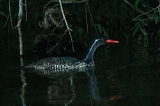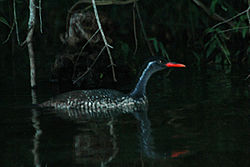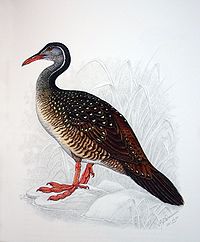
African Finfoot
Encyclopedia


Bird
Birds are feathered, winged, bipedal, endothermic , egg-laying, vertebrate animals. Around 10,000 living species and 188 families makes them the most speciose class of tetrapod vertebrates. They inhabit ecosystems across the globe, from the Arctic to the Antarctic. Extant birds range in size from...
inhabiting the rivers and lakes of western, central, and southern Africa
Africa
Africa is the world's second largest and second most populous continent, after Asia. At about 30.2 million km² including adjacent islands, it covers 6% of the Earth's total surface area and 20.4% of the total land area...
.
Description
The African Finfoot is an underwater specialist with a long neck, a striking sharp beakBeak
The beak, bill or rostrum is an external anatomical structure of birds which is used for eating and for grooming, manipulating objects, killing prey, fighting, probing for food, courtship and feeding young...
, and bright red, lobed feet. The plumage
Plumage
Plumage refers both to the layer of feathers that cover a bird and the pattern, colour, and arrangement of those feathers. The pattern and colours of plumage vary between species and subspecies and can also vary between different age classes, sexes, and season. Within species there can also be a...
varies by race, generally pale underneath and darker on top. The males are usually darker than the females. It superficially resembles South America
South America
South America is a continent situated in the Western Hemisphere, mostly in the Southern Hemisphere, with a relatively small portion in the Northern Hemisphere. The continent is also considered a subcontinent of the Americas. It is bordered on the west by the Pacific Ocean and on the north and east...
's Torrent Duck
Torrent Duck
The Torrent Duck is a member of the duck, goose and swan family Anatidae. It is the only member of the genus Merganetta. Today it is placed in the shelduck subfamily Tadorninae after the "perching duck" assemblage where it was formerly assigned to was dissolved because it turned out to be...
.
Habits and Range
The African Finfoot can be found in a range of habitatsHabitat (ecology)
A habitat is an ecological or environmental area that is inhabited by a particular species of animal, plant or other type of organism...
across Africa, where there are rivers, streams and lakes with good cover on the banks. This range includes forest
Forest
A forest, also referred to as a wood or the woods, is an area with a high density of trees. As with cities, depending where you are in the world, what is considered a forest may vary significantly in size and have various classification according to how and what of the forest is composed...
, wooded savanna
Savanna
A savanna, or savannah, is a grassland ecosystem characterized by the trees being sufficiently small or widely spaced so that the canopy does not close. The open canopy allows sufficient light to reach the ground to support an unbroken herbaceous layer consisting primarily of C4 grasses.Some...
h, flooded forest, and even mangrove
Mangrove
Mangroves are various kinds of trees up to medium height and shrubs that grow in saline coastal sediment habitats in the tropics and subtropics – mainly between latitudes N and S...
swamps.
The finfoot feeds on underwater invertebrate
Invertebrate
An invertebrate is an animal without a backbone. The group includes 97% of all animal species – all animals except those in the chordate subphylum Vertebrata .Invertebrates form a paraphyletic group...
s including both adults and larval mayflies
Mayfly
Mayflies are insects which belong to the Order Ephemeroptera . They have been placed into an ancient group of insects termed the Palaeoptera, which also contains dragonflies and damselflies...
, dragonflies
Dragonfly
A dragonfly is a winged insect belonging to the order Odonata, the suborder Epiprocta or, in the strict sense, the infraorder Anisoptera . It is characterized by large multifaceted eyes, two pairs of strong transparent wings, and an elongated body...
, crustacean
Crustacean
Crustaceans form a very large group of arthropods, usually treated as a subphylum, which includes such familiar animals as crabs, lobsters, crayfish, shrimp, krill and barnacles. The 50,000 described species range in size from Stygotantulus stocki at , to the Japanese spider crab with a leg span...
s, and on snails, fish
Fish
Fish are a paraphyletic group of organisms that consist of all gill-bearing aquatic vertebrate animals that lack limbs with digits. Included in this definition are the living hagfish, lampreys, and cartilaginous and bony fish, as well as various extinct related groups...
and amphibians. Finfoots are thought to be highly opportunistic, and take some of their prey directly off the water's surface. They are adept out of water (unlike their Sungrebe
Sungrebe
The Sungrebe or American Finfoot is a bird which breeds in tropical Central and South America from southern Mexico to northeast Argentina and southern Brazil....
relative's namesakes, the grebe
Grebe
A grebe is a member of the Podicipediformes order, a widely distributed order of freshwater diving birds, some of which visit the sea when migrating and in winter...
s) and forage on the banks as well.
Finfoots are usually seen singly or in pairs. They are very secretive; even experienced ornithologists see them very rarely (making them a prized sighting for birders and twitchers). Because they are so elusive it is not known if they spend most of their time in the water (where they are almost always seen) or on land.
Their time of breeding varies by area, usually coinciding with the rainy season. They build a nest, nothing more than a mess of twigs and reeds, on a fallen tree above the water. Two eggs
Egg (biology)
An egg is an organic vessel in which an embryo first begins to develop. In most birds, reptiles, insects, molluscs, fish, and monotremes, an egg is the zygote, resulting from fertilization of the ovum, which is expelled from the body and permitted to develop outside the body until the developing...
are laid and incubate
Avian incubation
Incubation refers to the process by which certain oviparous animals hatch their eggs, and to the development of the embryo within the egg. The most vital factor of incubation is the constant temperature required for its development over a specific period. Especially in domestic fowl, the act of...
d solely by the female. The chicks leave the nest a few days after hatching.
Relationships
The African Finfoot belongs to a family whose only other members are the Masked FinfootMasked Finfoot
The Masked Finfoot, , is an aquatic bird from the fresh and brackish wetlands of southeastern Asia, Indochina, Malaysia and Indonesia...
and the Sungrebe
Sungrebe
The Sungrebe or American Finfoot is a bird which breeds in tropical Central and South America from southern Mexico to northeast Argentina and southern Brazil....
. Their relationships to other birds are poorly understood.
Status and Conservation
The African Finfoot's conservationConservation biology
Conservation biology is the scientific study of the nature and status of Earth's biodiversity with the aim of protecting species, their habitats, and ecosystems from excessive rates of extinction...
status is hard to determine, given its elusive nature. It is not considered threatened, as it is not persecuted or targeted by hunters, and while scarce, it is very widespread. However, there is concern that it may become threatened, as wetland
Wetland
A wetland is an area of land whose soil is saturated with water either permanently or seasonally. Wetlands are categorised by their characteristic vegetation, which is adapted to these unique soil conditions....
s are cleared and watercourses altered and polluted
Pollution
Pollution is the introduction of contaminants into a natural environment that causes instability, disorder, harm or discomfort to the ecosystem i.e. physical systems or living organisms. Pollution can take the form of chemical substances or energy, such as noise, heat or light...
. It is also thought to tolerate only minimal disturbance. This and increased habitat fragmentation mean that the species needs to be monitored to safeguard it. There are currently no African Finfoots in captivity.

